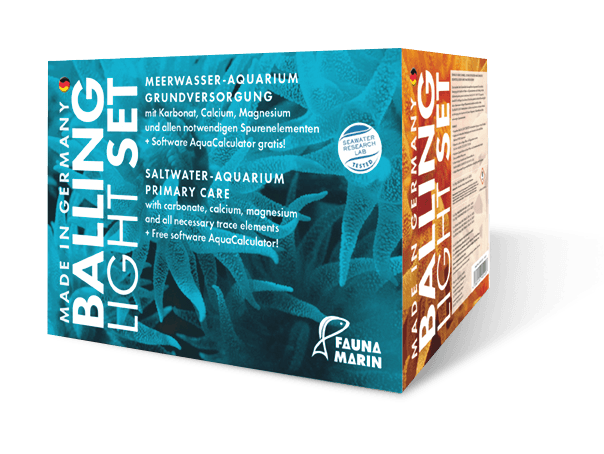Boron
Boron occurs in seawater in relatively low concentrations of around 4.5 mg/l(0,26 US.liq.gal.) and contributes, among other things, to the stabilisation of the pH value. To a small extent it is also involved in alkalinity but plays no major role here. In laboratory analyses, however, this proportion is co-determined in certain measuring systems, so that slightly different alkalinity values can occur compared to a classical drop measurement.
What is this:
Boron is present in seawater as boric acid. With 4-6 mg/l(0,26 US.liq.gal.) it still belongs to the macro elements despite its low content in seawater. Boron is essential and is mainly needed for growth and stabilisation of cell membranes. Boron also contributes to the carbonate system, albeit only to a few percent. A high concentration of boron suppresses the effect of too high aluminium levels.
Problems:
A too low boron concentration inhibits the growth of the corals and, at extremely low values (below 2 mg/l (0,26 US.liq.gal.) also leads to partial tissue detachment which can be bubble-like.
Measures:
Regular control of the boron value, if necessary adjustment of the dosage. Reduction by partial water change and adjustment of the supplemental dosing.
Indicator species:
A too low boron concentration in the aquarium water is reflected in low coral growth. Especially fast growing species react quickly and stop growing.
Value too high:
Reduce the addition dosage, perform partial water change, avoid values above 10 mg/l (0,26 US.liq.gal.), employ Zeolight, Phos Adsorber
Value too low:
Dose Elementals B
| Variety | Semi-metal |
|---|---|
| Reference value | 4 – 5 mg/l (0,26 US.liq.gal.) |
| Skill Level | Orange, only for experienced aquarists |
| Source | salt mix, supply systems, trace element mixtures |
| Available | Elementals B, Balling-Light-System, Color Elements, Organic |
| Importance 1–6 | 5 |
| Detection quality | safe |
| Relation ratio | Salinity |

Balling Light:
When using the Balling Light system, boron concentrations are not too high. Values between 4–5 mg/l (0,26 US.liq.gal.) are sufficiently high, for SPS tanks and strong lighting, a slightly higher value of 5–6 mg/l (0,26 US.liq.gal.) is advisable. This can be set using Elementals Boron. Once you have determined the consumption, you can add the daily dose to your calcium container (canister 1).
Boron
Boron is essential and is needed by corals and biofilms. Therefore it is subject to a low but constant consumption, which should be controlled and adjusted regularly. With the regular partial water change with our sea salt, this is usually also sufficiently supplied. Boron is also a component of the Balling Trace 1 elements and is automatically added in the appropriate quantity via the calcium consumption. For SPS lovers we recommend values around 6 mg/l (0,26 US.liq.gal.), the colour effect is more metallic and shiny.
Boron is a component of many functions within the photosynthesis and metabolism of corals, but also forms functional complexes in biological systems. Boron also acts as an inhibitor here, preventing excessive production of antibodies in algae.
Tanks with mud filter or refugium usually have a slightly higher consumption. Aquaria with correctly adjusted boron levels show better coral growth. The Balling Light method usually compensates for this automatically via the correspondingly increased calcium supply. However, the boron value should be checked by means of ICP, as the consumption of boron is, unlike other elements, unspecific and can therefore fluctuate.
Boron can be replenished via Fauna Marin Professional Sea Salt or the addition of Fauna Marin Trace 1 and Color Elements Blue or increased with Elementals B.
A too high boron value can be compensated by partial water changes.
Tip:
As boron is an essential element in reef aquaria, this value should be observed carefully. Bright colours and metallic shiny SPS corals need a correct or slightly increased concentration of boron in the water. Even multi-colouring and contrast formation of the colours are hardly possible without a boron value above 4 mg/l (0,26 US.liq.gal.).